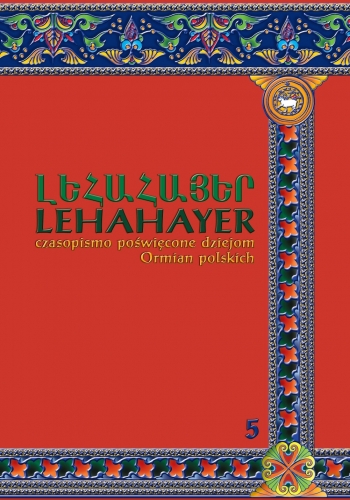Velum ormiańskie ze zbiorów Muzeum Uniwersytetu Jagiellońskiego
The Armenian Veil of the Jagiellonian University Museum Repertory
Author(s): Joanna Sławińska, Jakub OsieckiSubject(s): Cultural history, Social history
Published by: KSIĘGARNIA AKADEMICKA Sp. z o.o.
Keywords: veil; Armenian Moush art; Moush Monastery; Jagiellonian University Museum; Schlesisches Museum für Kunstgewerbe und Altertümer
Summary/Abstract: The Jagiellonian University Museum stores an Armenian liturgical veil made of thin cotton fabric decorated with silk and metal thread embroidery. Before the veil came into the possession of the Museum in 1945, it had been stored in Schlesisches Museum für Kunstgewerbe und Altertümer in Wrocław which had previously purchased it from dr Dorothea Willers in 1936. The analysis of the inscription on the fabric gave the following results: the veil was a gift from townsfolk, probably from Chars (Moush province), for St John the Baptiser Monastery in Moush (in Taron, an ancient Armenian province). For Armenians the Monastery used to be one of the most frequently visited pilgrimage sites before it was destroyed during genocide in 1915. Some of its possessions were moved to Ejmiatsin and later to Moscow. There they got dissipated after the October Revolution and have never returned to their rightful owners. The veil shows the following iconography: an image of light ray-crowned Agnus Dei typical for Armenian chalice veils, Salvor Mundi image of enthroned Christ, images of St Stephen and St John the Baptiser widely worshipped in the Armenian Church, and St Hripsime. The form is typical for Eucharist-themed Christ images (the chalice and Arma Christi symbols). Stylistically, the embroidery reflects the Eastern Armenian art characteristic in its decorative and ornamentation qualities. There are formal parallels between the veil and Armenian chalice veils from the 19th century, which allows to date the Jagiellonian Museum veil at that century.
Journal: Lehahayer. Czasopismo poświęcone dziejom Ormian polskich
- Issue Year: 2018
- Issue No: 5
- Page Range: 195-243
- Page Count: 49
- Language: Polish

